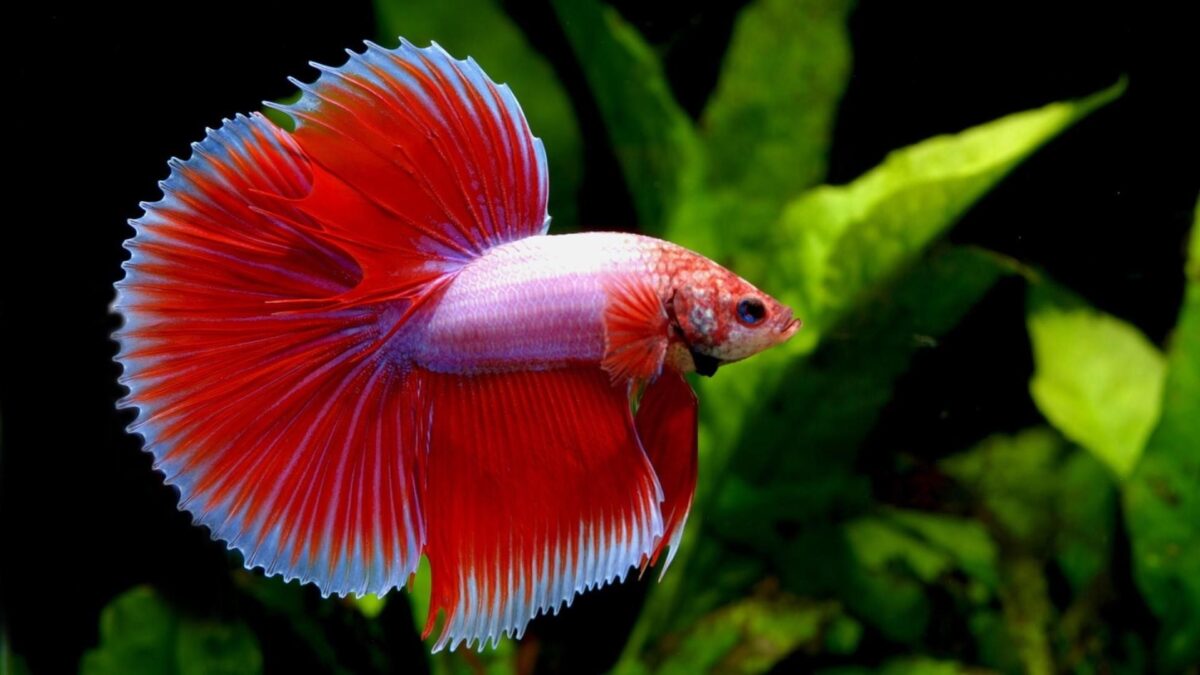The betta fish, also popularly known as the Siamese fighting fish, is a brilliantly vibrant species that is worldwide loved and adored.
Roughly speaking, there are nearly more than 100 betta fish types with slight to significant differences in their behavior, color, fin, patterns, etc.
If you are a novice fish keeper or aquarium enthusiast, the sheer amount of choices between the betta fish types will leave you astounded.
Thus, to help you make a quick yet informed decision, we have curated this comprehensive guide that focuses on different types of betta fish based on their fin, color, and patterns.
We have also included a few answers to the most asked questions to help you shortlist these fishes accordingly.
Contents
Types of Betta Fish
To cover the maximum number of betta fish types, we have segmented this article into three sections as follows:
Tail Types
The tail is the most striking feature that sets different types of betta fishes apart. Fish enthusiasts like you are spoiled for choice- from long wavy fins to vibrant short fins.
Veil Tail
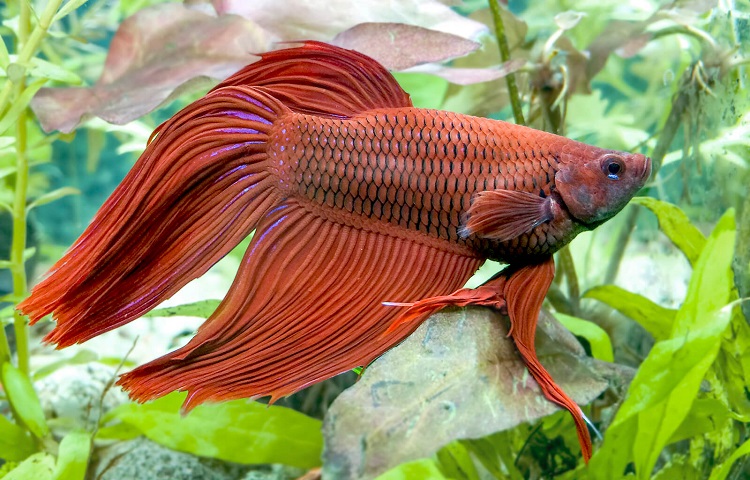
Specs
- Color: Multiple colors
- Fins & tails: Long flowing fins with a swooping tail. Large anal and dorsal fins
- Typical patterns: Butterfly, dragon scale, piebald, full mask, solid
- Behavior: Less aggressive
The Veil tail is undoubtedly one of the most common betta varieties available. One can quickly notice their most distinctive features: their long tail swoops and curves as it trails behind its body.
You can easily find this betta in numerous patterns; however, marble and koi patterns are comparatively rare to find. The male Veil tails have a reasonably large tail that looks impressive compared to the female version. However, the females often have brighter colors that balance the short tail drawback.
Keep in mind that Veil tails are not strong swimmers, so consider keeping them in a tank with gentle water currents.
Crown Tail
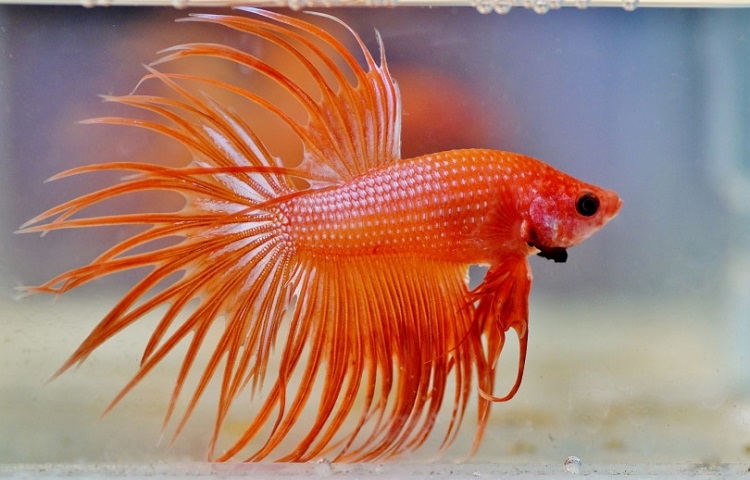
Specs
- Color: Multiple colors
- Fins & tails: Webbing between rays and long spikes on dorsal, caudal, and anal fins
- Typical patterns: Full mask, grizzle, solid, butterfly, dragon scale
- Behavior: A little aggressive
Crown tail bettas were bred in 1997 in West Jakarta, Indonesia, and are now seemingly popular everywhere. As the name suggests, this betta type has a glorious tail ending featuring countless tiny spikes that can make any aquarium spectacular.
Their tail spikes always extend past their webbing, giving them a crown-like appearance. These Crown bettas can have double, triple, quadruple, or even crossed ray extensions. Grizzly and bi-color patterns are the most easily found varieties of these types of betta fishes.
Unlike Veil tail bettas, Crown tail betta fishes are powerful swimmers and can easily tolerate subdued current. Similarly, the variety is slightly aggressive depending on the fish’s gender and ancestry. Since Crown tails are prone to injuries and diseases, you need to take utmost care. Generally, they thrive in pristine water conditions.
Delta
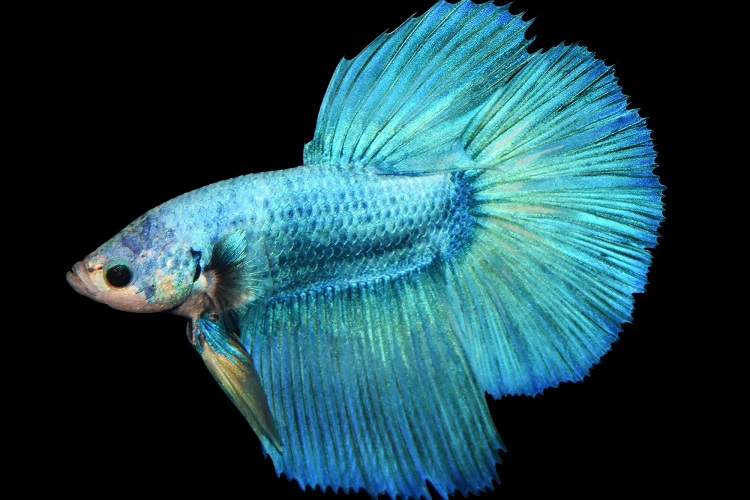
Specs
- Color: Multiple colors
- Fins & tails: Caudal fins usually flare out, forming a triangle
- Typical patterns: Solid, dragon scale, full mask, bi-color, grizzle
- Behavior: Aggression subjective to fish’s ancestry
Delta bettas have flawless tails shaped like the Greek letter- Delta (Δ). Because of its appearance, it has earned the name Delta. These Delta bettas have a long spread tail without any distinctive crown.
The main difference between Delta and other bettas is the proportion of its tail. Their tail is evenly spread out on the upper and lower sides, making the feature its most distinct quality. These Deltas are most likely a crossing between Halfmoon and Veil tail bettas.
Double Tail
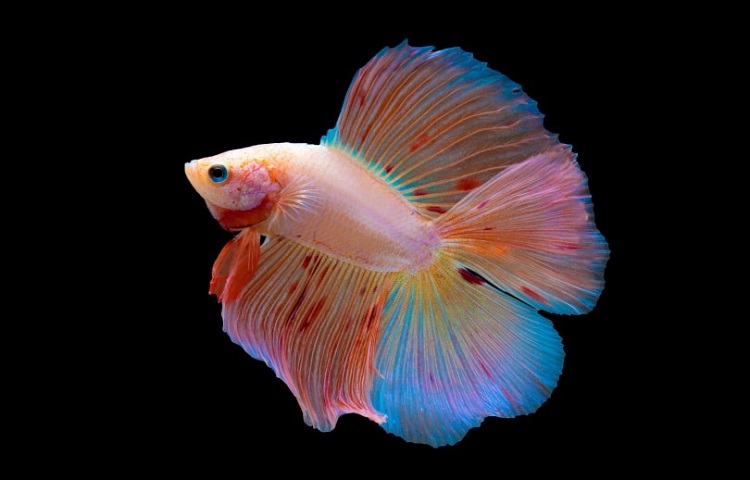
Specs
- Color: Available in all colors
- Fins & tails: Two noticeable caudal fins, separated at the base
- Typical patterns: Piebald, bi-color, solid, butterfly
- Behavior: Typically slight aggressive
The name Double tail betta is monikered because of their double caudal fin. However, DT betta is comparatively more common amongst fish enthusiasts. Their caudal fins aren’t split but have two different peduncles, making them distinctive and different from other species. Unlike the Delta bettas, this betta’s tails may or may not be proportionately distributed.
These species usually come in numerous color variations and have bi-color, piebald, butterfly, and soil patterns. Since their dorsal fins have more rays than a typical betta, they look incredibly vibrant.
Half Moon
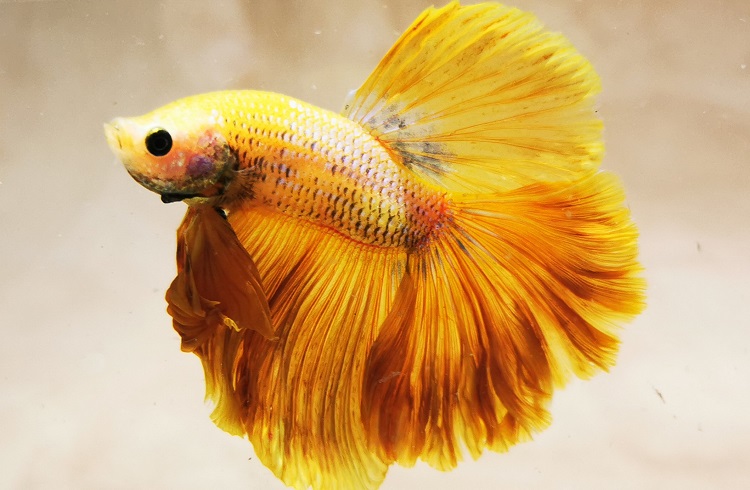
Specs
- Color: Multiple colors
- Fins & tails: Flowing 180° tail with overlapping anal and dorsal fins
- Typical patterns: Butterfly pattern, dragon scale, solid
- Behavior: Aggressive than Veil tails
Half-moon bettas have a fat rounded tail that spreads a beautiful 180° giving it a semicircle shape. In the darkness, the silhouette of their tail usually gives off a half-moon appearance. In addition, their dorsal fin is also large and showcases a rounded shape.
Their anal fins, on the other hand, form a giant curtain under the betta’s belly. Their flowing fins will usually look like a blooming flower when the betta swims leisurely in your fish tank. Although quite rare, you can still spot these beautiful Half-moon bettas in koi patterns too.
Rosetail

Specs
- Color: Available in all colors
- Fins & tails: Tails with extra rays and thick ruffled edges
- Typical patterns: Solid, butterfly, bi-color, dragon scale
- Behavior: Aggressive
The Rose tail betta is a unique species that lightly resembles the Half-moon bettas because of its similar tail region. The only difference that makes them stand apart is the betta’s extra rays and beautifully ruffled edges.
These rays also make their tail fold back and forth on themselves. Their frilly appearance is loved chiefly by fish hobbyists who like patterns that mend well with water’s flow. Buyers must remember that these Rose tail bettas are aggressive and need a separate space to avoid fights with other fishes. Additionally, they also are highly prone to infections.
Plakat
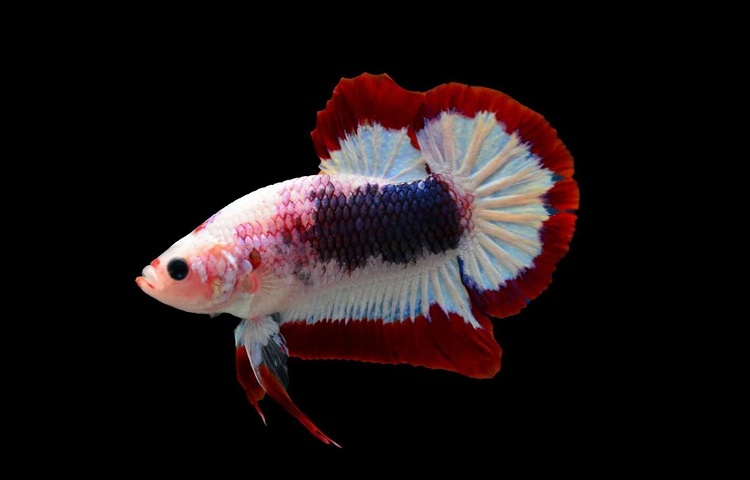
Specs
- Color: Multiple colors
- Fins & tails: Short tail with minimally ornate fins
- Typical patterns: Marble, koi, solid, butterfly, dragon scale
- Behavior: Extremely aggressive
Plakat bettas resembled the wild betta Splendens and were bred initially in South Asia for fighting. Because of their highly aggressive nature, they have shorter fins but large and distinctively strong bodies.
Traditionally speaking, these Palkat bettas used to have pointed or rounded tails. However, with the increased experimentation of selective breeding, you can find crowns or half-moon tails from the fish dealer.
One must note that these bettas have a habit of jumping out of their tanks almost regularly. So opting for a tank with a tight lid is an absolute must. Moreover, to keep your aggressive Plakat happy, consider switching to a larger tank where they can move a lot and be active.
Feathertail
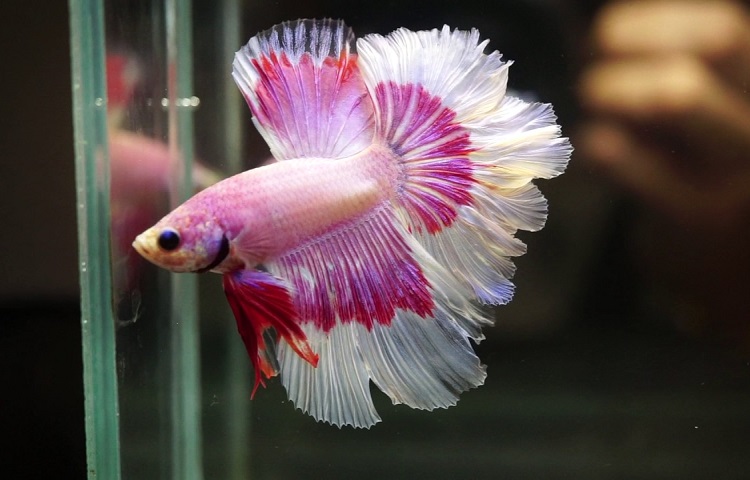
Specs
- Color: Multiple colors
- Fins & tails: Ruffled dorsal, anal, and caudal fins
- Typical patterns: Dragon scale, solid, butterfly, full mask, grizzle, bi-color
- Behavior: Fairly aggressive
Feathertail bettas have wide, long ruffled fins that are somewhat identical to Rose tail bettas. But, instead of having a half-moon shape, their tails and fins have triangles. These triangles often give them the most sought-after feathery appearance.
These bettas can be prone to broken rays, ragged fins, and tail biting, drastically shortening their lifespan. Thus, owners need to be extremely careful and take great care of this reasonably aggressive breed of bettas to keep their beauty intact.
Round Tail
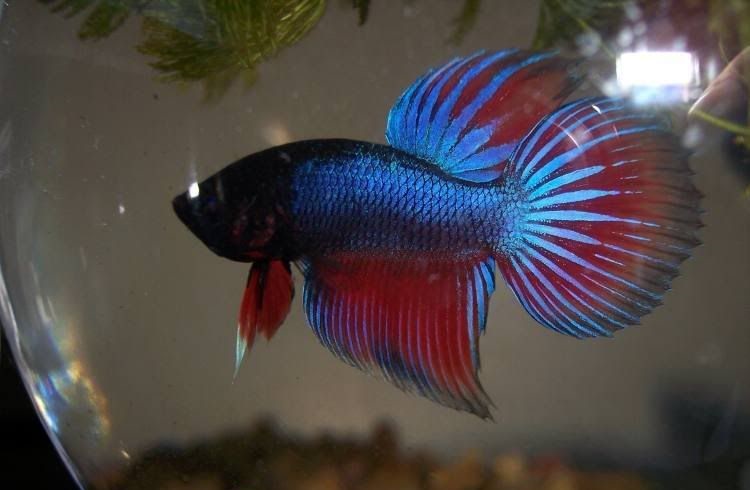
Specs
- Color: Multiple vibrant colors
- Fins & tails: Single tail with rounded edges
- Typical patterns: Solid, butterfly, dragon scale
- Behavior: Less aggressive
Round tail bettas are extremely popular in the fish realm and are usually easily found in any pet store. The name suggests that their tail features a circular round without straight edges.
In addition, the fish also comes in numerous patterns and vibrant hues based on individual choice. We highly recommend these fishes if you want to house a pet fish that is comparatively less aggressive.
Spade Tail
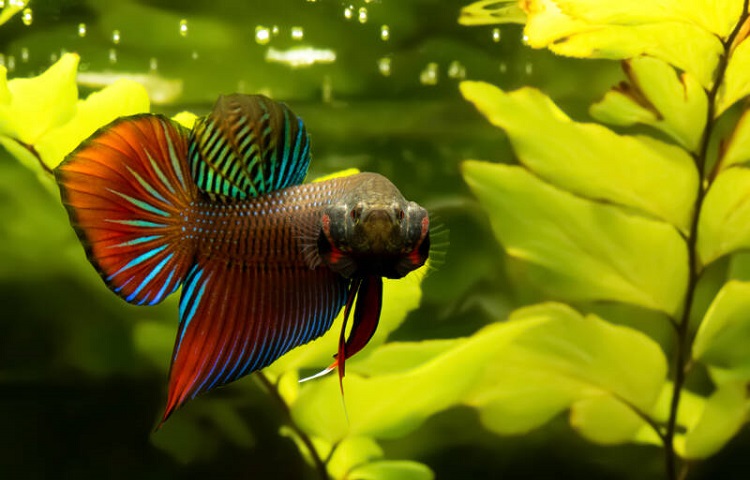
Specs
- Color: Available in all colors
- Fins & tails: Tail flares out curving to a point with large dorsal and anal fins
- Typical patterns: Dragon scale, full mask, bi-color, solid, piebald
- Behavior: Less aggressive
Spade tails bettas are an advanced variation of the Veil tail bettas. The tail of these fishes forms a similar round shape typically spotted on females and juvenile bettas.
The Spade tail has a single point on its caudal fin resembling a spade that one sees on playing cards. The tail spread should be proportionately equal on both sides with a slight curve at the back. We can say that these bettas are pretty hard to find these days, but they had their golden days in the late 90s to early 2000s.
Elephant Ear/Dumbo
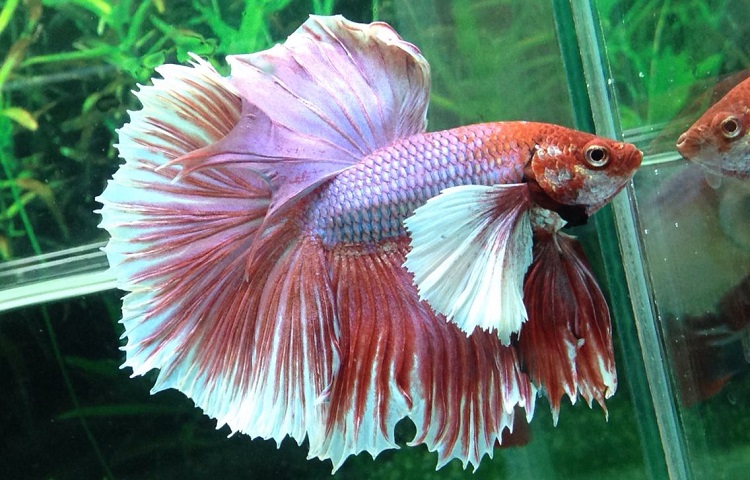
Specs
- Color: Multiple colors
- Fins & tails: Ruffled pectoral fins with Half-moon betta tails
- Typical patterns: Solid, dragon scale, piebald, butterfly, grizzle
- Behavior: Slightly aggressive
Dumbo Bettas or elephant ear bettas have peculiar enlarged pectoral fins approximately five times bigger than traditional ruffled edged fins. You’ll notice a beautiful feathered fan when these bettas swim using their pectoral fins.
They are comparatively hard to breed, but they are highly desired and are primarily hard to find. If you manage to house these species, always ensure that they are put in a gentle current to swim with ease.
Color Types
Now that you are familiar with some species, we would like to introduce you to several classic and interesting color types of betta fishes.
Thanks to selective breeding, you can get a hold of any betta fish type with a vibrant hue and shade.
Albino
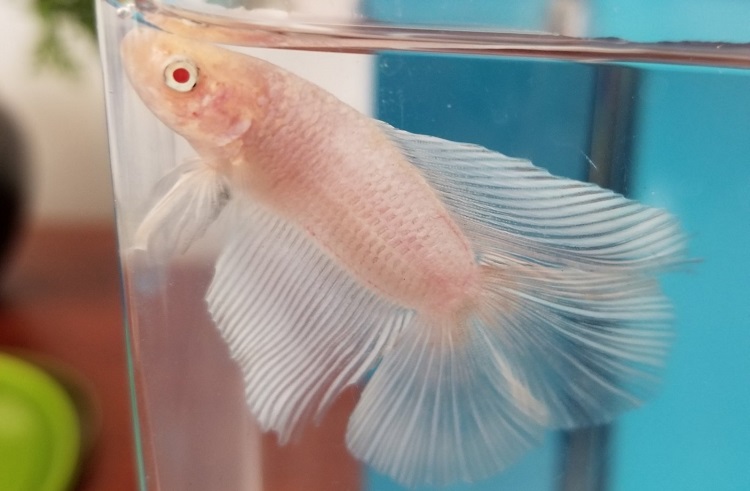
An albino betta is known for having zero pigmentation. The fins and scales of these albino bettas are usually transparent, with a hint of red in the eyes.
However, true albino bettas are highly uncommon, so most fish enthusiasts always debate their existence in today’s world. These albino bettas are hugely challenging to breed and possess a relatively low survival rate.
Clear/Cellophane
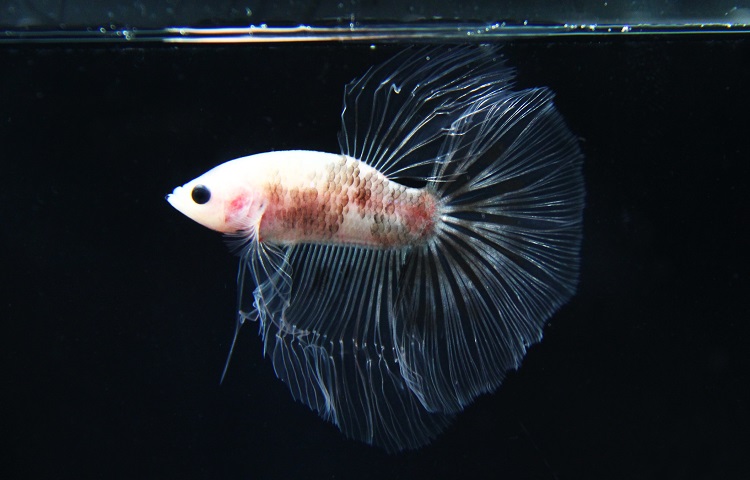
The cellophane or clear betta usually has translucent scales that look whitish under specific lighting. If the fish is exceptionally translucent, you can almost catch a glimpse of their internal organs.
Different breeds have different colors ranging from pure sheer to milky white opaque tint. The pupils are primarily black, while the body appears to have a white hue all over.
White
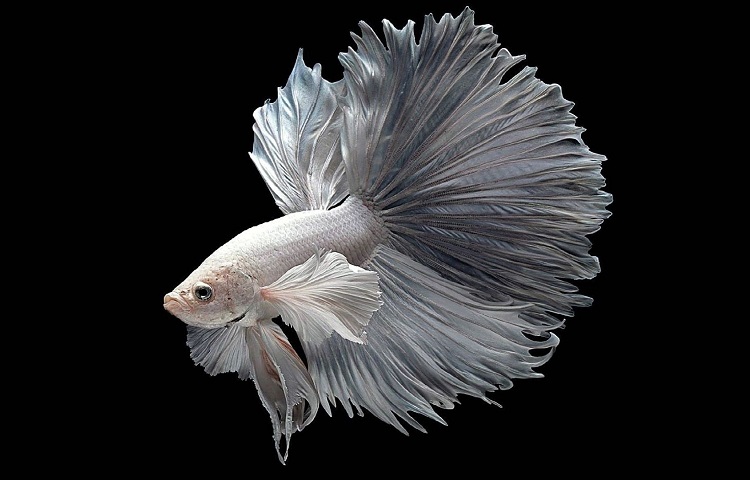
Many people misunderstand white bettas as cellophane bettas. However, these bettas have a distinctive opaque white shade over their body. The fish does not possess any reddish undertones of internal organs.
Although this fish might appear a little bland compared to other punchy colors, they look breathtaking when placed in a well-lit fish tank. Halfmoon and crown tail fish look the most majestic in this particular color.
Yellow
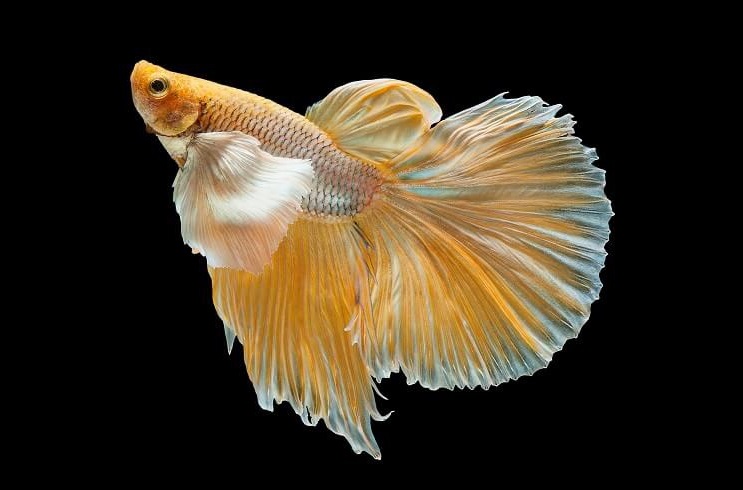
Yellow betta fish is genuinely one of the most commonly found colors in the betta fish family. Yellow-colored bettas usually have a rich shiny body featuring vibrant yellow shade throughout the fins and tail.
The available shades start from extremely bright yellow to a more tanned or muted mustard yellow. However, you can always search the stores to find your desired shade of yellow in your selected betta species.
Mustard Gas
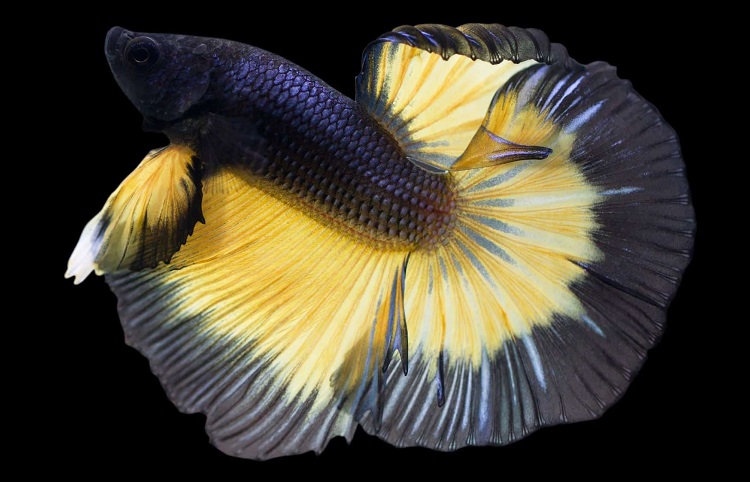
If your tank needs a much-needed boost of color, consider opting for mustard gas-colored bettas. These are bi-colored bettas with color variations between their fins, tail, and the rest of the body.
Their body usually showcases a dark color from the green or blue family, while their fins have a yellow-orange shade.
Other colors that are relatively popular and common include:
- Blue
- Pink
- Rose
- Copper
- Chocolate
- Green
- Pastel
- Orange
- Purple
- Red
- Black
What is the rarest betta color?
The rarest betta color has to be the albino betta. The color is so rare that fish hobbyists usually have a heated debate over its existence, much like pure black bettas. Apart from albino- pure, vibrant purple and green bettas are considerably rare to find.
Pattern Types
Last but not least, you can differentiate a betta by its pattern type which is based on its physical pattern on the body and fins.
Koi

As the name implies, koi bettas have a similar pattern to koi fish. These koi fishes have an abstract marbled pattern with blotches of several colors and random spots all over their body. Koi bettas also have the same color palette as koi fish featuring red, white, orange, yellow, and black.
Bi-Colored

Bi-colored bettas have two different hues on their body and fins. The shades can vary from punchy, vibrant colors to pale muted colors based on the betta fish type. Usually, you find dark-colored fins with light bodies. However, light fins with a dark body can also be seen in rare cases.
Butterfly
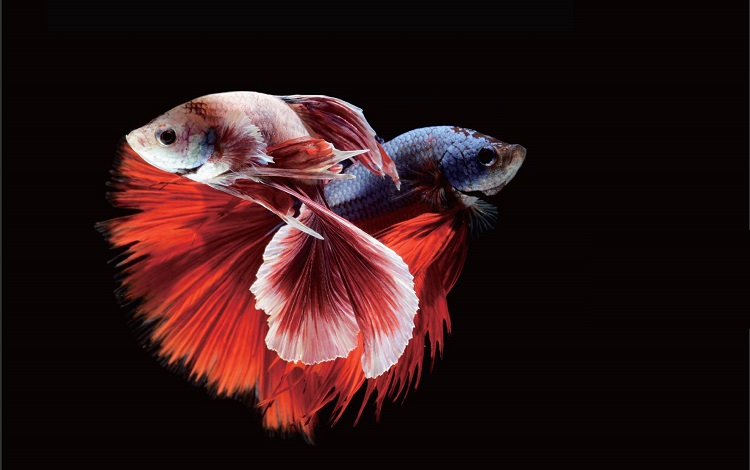
Butterfly bettas mimic a distinct butterfly pattern featuring fluttering wings on the body. These butterfly betta fishes look extraordinarily graceful and breathtaking while swimming in a fish tank.
They possess a single color with contrasting dark and light shades throughout the body and the fins. However, the edges have another color with a hint of white in between.
Cambodian
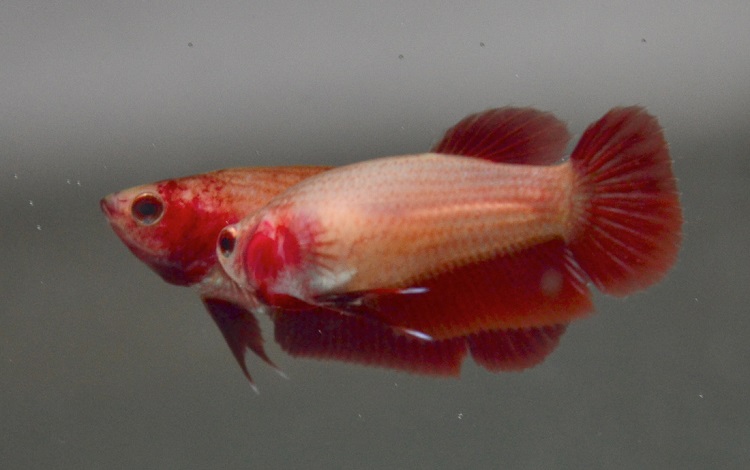
As a result of numerous selective breeding steps, the Cambodian bettas possess a pale pink body with flaming bright red fins. You can find these Cambodian bettas in multiple colors; however, one thing that differentiates them from other types of bettas is their signature flesh pink color.
Dragon Scale
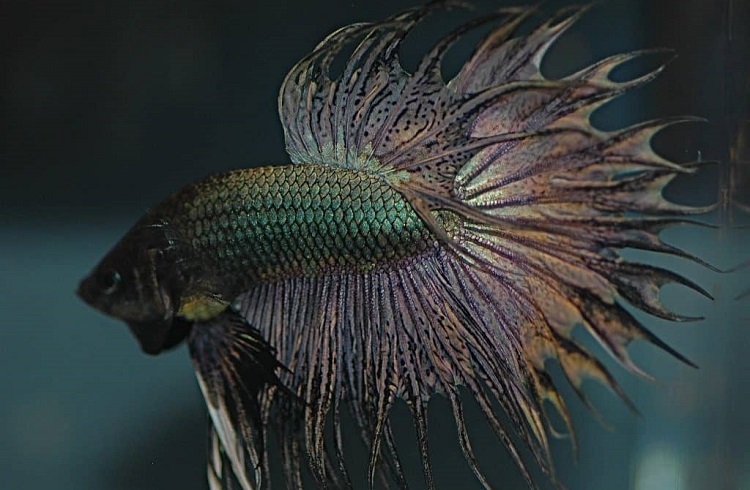
Dragon Scale is a relatively newer pattern that was carefully introduced via selective breeding. The design is trendy because of its bright gun-metal metallic color.
These dragon scale bettas have a deep solid color on the body with scales that resemble a miniature dragon or lizard. The base of these bettas has a rich color with magical iridescent pale scales through the body.
Marble
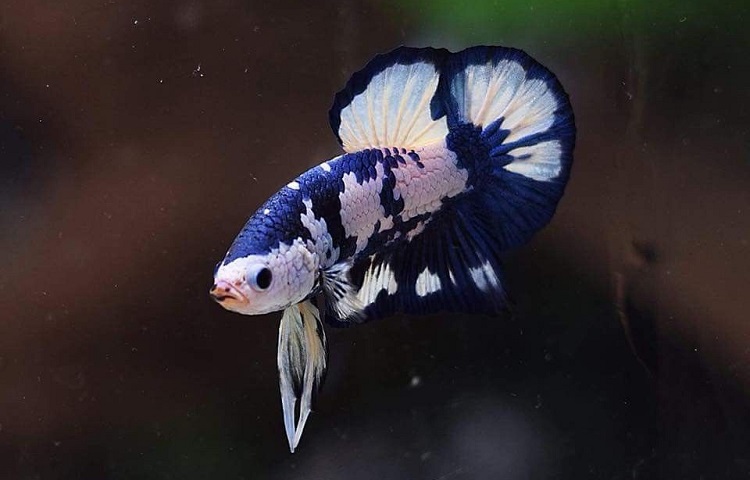
According to the species, marble bettas have splotches of white on their fins or body. This highly sought-after pattern generally develops throughout a betta’s lifetime.
The process of this pattern accumulation is called marbling. The DNA sequence usually changes its position in the fish’s genome, thus altering the cell at a cellular level creating such a marbled pattern.
Mask

Mask bettas showcase the same color as their body, while half-mask bettas have two colors. Most mask bettas have a body with a different color than its head, while a half-mask betta has a single color on one side of their head and another on the other half.
What type of betta is most aggressive?
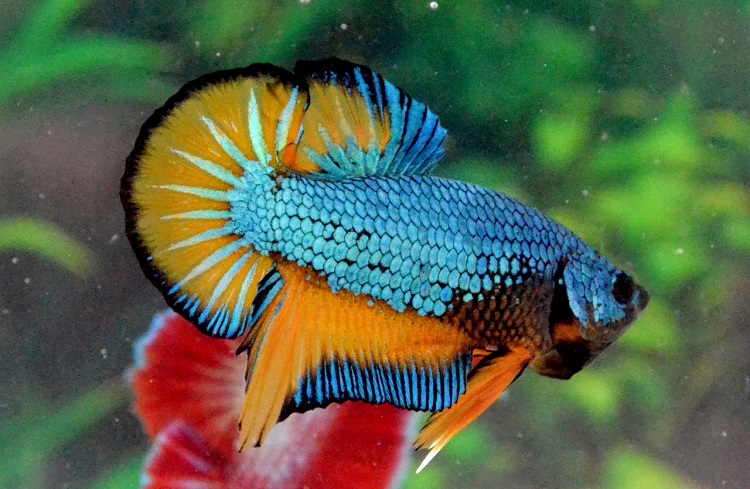
Plakat bettas are undoubtedly the most aggressive breed of bettas in the fish realm. Since people bred these fishes for fighting, they still possess these traits that make them highly destructive.
These fishes also have a habit of jumping from the fish tank. Apart from Plakats, Crown tail bettas are also fairly aggressive. These bettas are highly territorial and are always ready to attack.
What type of betta is the least aggressive?
The Betta Imbellis is the least aggressive species in the betta fish family. These bettas are highly docile and have a very calm and well-behaved attitude throughout their life.
You can easily keep these bettas with a mixed-sex group in the same tank. Brunei beauty betta is another docile species. Lastly, Veil tail bettas are also relatively calm and peace-loving bettas that require less human interference.
Before buying any betta species, you must note that the aggression levels also depend on the personality and genetic history of the specified fish.
Summary
Bettas have an astounding array of types and subtypes based on the color, fin-type, and pattern. If you are a newbie fish enthusiast, we highly recommend opting for fishes that are very docile and less aggressive.
Since these fishes are small, a 5-gallon tank would easily suffice their movement needs. However, steer clear of tiny fishbowls, especially if you plan to buy aggressive bettas.
Lastly, Petmd suggests that most betta species thrive when they are kept alone in the tank without any different fish species.
Which betta fish are you gravitating toward the most?

Ian Sterling, founder of Fishlab.com, began his aquarium journey over 30 years ago, driven by a deep fascination for fish and their diverse personalities. His website, Fishlab.com, is dedicated to making fishkeeping accessible and enjoyable, offering beginner-friendly guidance, expert insights, and a community for aquarists to connect and share experiences.


